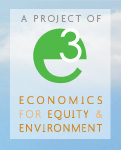This blog post originally appeared on Climate and Development Knowledge Network.
Some economists conclude that the best response to climate change is to allow greenhouse gas emissions to keep growing throughout this century, although making sure their growth is slower than under a “business-as-usual” (no policy action) scenario. Others economists say the best policy is to lower emissions quickly, starting as soon as possible, and eliminating all greenhouse gas emissions before 2100. How can scholars using the same basic set of analytical tools come to such radically different policy recommendations?
A new report from the Stockholm Environment Institute uses the CRED model to show how three simple changes can turn a slower-emissions-growth policy into a call for immediate, steep reductions. Here the slower-emissions-growth policy is defined as one that allows carbon dioxide emissions of 5,400 thousand million tons (gigatons or Gt) during the 21st century. The immediate, steep reductions policy is defined as capping cumulative 21st century emissions at 2,000 Gt and providing a 4-out-of-5 chance that temperature rise will stay under 2°C. The three changes to the economic model can be described in short as: reason, empathy, and fair play.
The first change, reason, requires understanding and believing the most up-to-date climate science. When climate-economics models start with the assumption that high temperatures and rising seas won’t cause a lot of damage, that’s what their results will reflect. In these models, bringing the relationship between climatic changes and economic damage better in line with current scientific findings increases the importance of lowering emissions.The second change, empathy, involves this generation’s concern about the well-being of future generations. For most countries, climate change’s worst effects will be felt 100 or more years into the future. When models start with the assumption that “human welfare” today and in the near future is almost all that matters, that too is what their results will reflect. Alternatively, if models are programmed to place a high value on the well-being of our children and grandchildren, the result is a greater urgency to stop emissions quickly.
Finally, fair play is a willingness on the part of rich countries to invest in emissions and poverty reduction in poor nations. When models assume that global inequality cannot be changed, then their results will also reflect that. Assuming instead that countries can, and will, help one another to solve the climate problem gives these models more and better tools for lowering emissions, making climate policy cheaper and easier to achieve.
Without reason, empathy, and fair play, climate-economics models do their best to show a path that maximizes human welfare, but they are based on faulty and controversial assumptions. Economists using models with these biases call for a slow, cautious climate policy. This is a “best” response only if you don’t believe the recent climate science, don’t care enough about future generations, and don’t believe that rich countries can, or will, fund emissions reductions in poorer countries.
When instead economists account for reason, empathy, and fair play in their modeling, the best climate policy is clear: share resources to reduce worldwide greenhouse emissions as fast and as far as possible.

